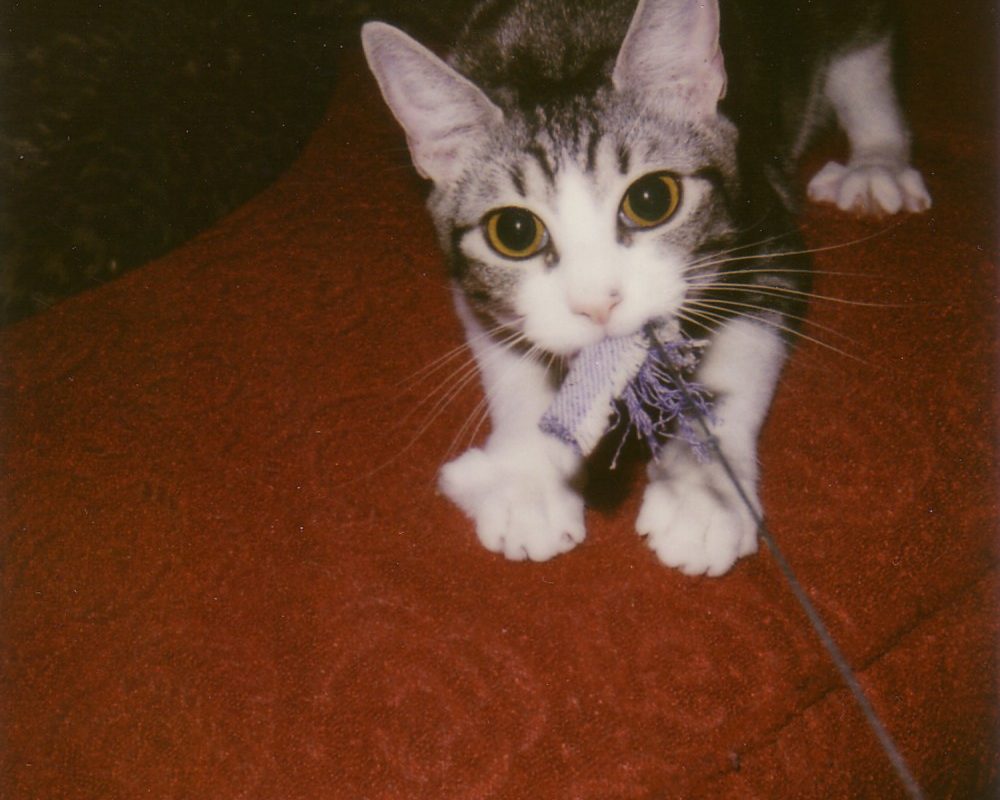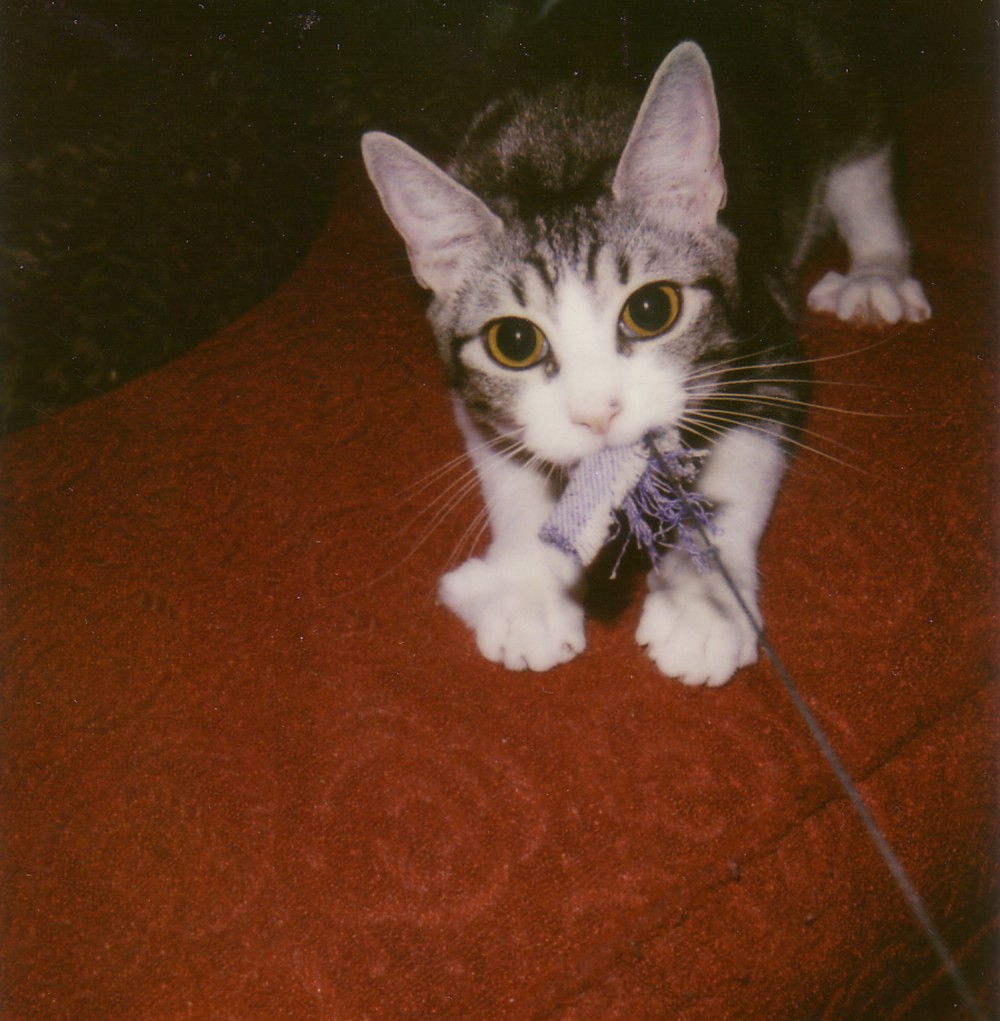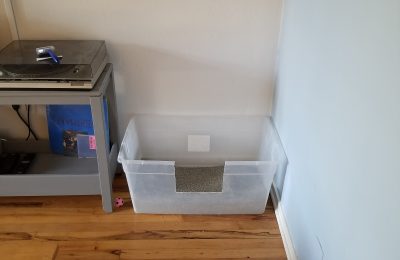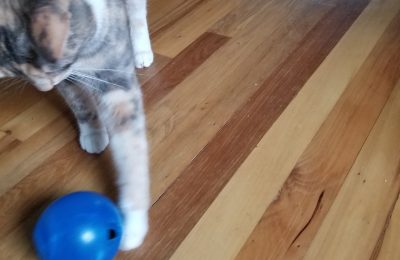I thought for my last blog post in 2013, I’d keep things fun! Some people like to make New Year’s Resolutions (I’m not really one of them!), so I thought I’d give those of you who share your home with a cat a few easy suggestions to help increase your cat’s happiness, and enhance your relationship with your feline friend.
1. Play with your cat with interactive toys DAILY
Interactive play (and I don’t mean throwing a mouse across the room) provides exercise and mental stimulation for your cat, and is a great way to bond (especially if your cat isn’t particularly cuddly).
Play is your way of bringing the hunting experience indoors to your kitty – so use prey-like toys and act like prey – vary your movements, wiggle toys under or behind objects, and don’t make the play too easy OR too hard. Let your cat have contact with the toy regularly – they have lots of nerve endings at the ends of their whiskers on their face and paws that make the tactile part of play very important.
Think your cat doesn’t play? My goal is to prove you wrong! Make sure you are using all of your cat’s senses – including sound, to engage them. Try moving the toy very slowly – remember that cats are “stalk and rush” hunters, so often the fun for them is when the toy is barely moving!
Some great prey-like toys:
Remember, for safety, be sure to put interactive toys away when you aren’t supervising!
2. Make your cat work for her food
If your cat were engaging in their normal hunting behavior, they wouldn’t go outside and find a bowl of mice. Foraging puzzles are commonly used in zoos, and giving animals the challenge of problems to solve may aid in their well-being. Another study showed that foraging puzzles reduced stress behaviors in captive felines in two zoos.
If you feed kibble – try putting the bowl away and giving your cat food in a food-puzzle! There are many excellent toys out there you can buy, or you can make one yourself! See the Instructables web-page for one of the coolest kitty-powered feeders I’ve seen in action (I’m definitely making one of these for my cats!).
Some pre-made options
- Fundamentally Feline’s excellent foraging puzzles
- Pet Safe’s Slim Cat
- Catit Digger
If you feed wet food, don’t despair. Try spreading a small amount of wet food on several yogurt lids and place them in different areas – encouraging your cat to climb up on perches or cat furniture for some of them. You can also distribute wet food in different cups of a muffin tin to encourage them to work or use a small dog Kong, which you can stuff with wet food.
3. Provide vertical, “cats-only” space
You might “let” your cat sit on your furniture (or you might not have much choice), and that’s great. But…perhaps your cat wishes she didn’t have to share the couch with YOU! A cat condo, tree or perch will give your cat her own space to hang out. Most cats love to be up high, and a cat condo can maximize space in a small apartment, and will provide your cat with exercise and a view. Even better, a cat tree with sisal-wrapped legs gives your cat important vertical scratching options. In homes with multiple cats, cats and dogs, or cats with kids, a cat tree is a must. AND, nowadays, you can’t use “they are beige carpet and ugly” as an excuse any more — many lovely, stylish options (can you say Hauspanther?) to be found for the aesthetically picky!
4. Try clicker training your cat
Perhaps you think as I once did “If I wanted to train an animal, I’d get a dog” or “cats can’t be trained!” Well, now I know better. My own cats can sit and high five on command, and people I know who are much more dedicated trainers than I am have trained their cats to do all kinds of cool (and sometimes handy) things, like find their car keys and go into their cat carrier.
Clicker training is a way to make training easier for humans; it makes our responses to behaviors clear. Briefly, the way it works – when the animal performs a behavior you like – you “click” and treat – and the animal learns that the behavior they performed will lead to rewards, making them more likely to repeat that behavior in the future. The click sound can be instantaneous, and helps us communicate more effectively to the cat that they just did something we like, and we are going to pay them for it in treats (or play or praise, something they REALLY like).
Why I love clicker training: it gives you a new way to communicate with your cat, and helps us attend to good behaviors instead of bad (find yourself saying “no” to your cat a lot? TRY CLICKER TRAINING!). Plus it really impresses your friends when your cat can jump through a hoop!
5. Take your cat to the vet for a yearly check-up

http://www.flickr.com/photos/
chikawatanabe/, via Creative Commons.
Cat owners are less likely than dog owners to take their cat to the vet for a check-up. This may be for several reasons. Many cats have not been trained to get into their carriers, and it can be a real struggle for owners just to get them to the veterinarian. Not all veterinary offices use “cat-friendly” practices (such as cat-only entrances), or have staff who are skilled with “difficult” cats. Many cats can be fear aggressive at the vet’s office (I’ve sadly heard from some clients that they have been asked not to bring their cats back), and these cats are mistakenly labeled as “bad cats” – but they deserve health care too! Another reason owners do not bring cats to the vet is that they may not realize that the cat needs medical attention. Unfortunately, cats can be good at hiding signs of pain and discomfort until things have progressed, which is why it is good to get preventative check-ups.
While your cat needs a yearly check-up, changes in appetite, litterbox behavior, energy level, and appearance/grooming habits may all be cause for concern and an immediate call to your veterinarian. Other behavioral changes such as increased vocalization and aggression may also indicate medical issues.
All five of these suggestions could merit a full blog post in and of themselves, but I hope you got some ins-“purr”-ation from these suggestions! May you and your furry ones have a great 2014!






